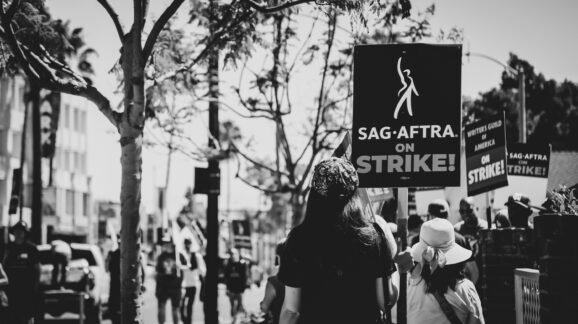The existential threat AI poses to the Screen Actors Guild

Photo Credit: Getty
The Screen Actors Guild recently concluded a lengthy strike against Hollywood studios with a contract that included new protections for its members from artificial intelligence (AI) programs. This isn’t the definitive win that some in the union, officially the Screen Actors Guild-American Federation of Television and Radio Artists, wanted because it means that AI programs can still replace actors.
Just typing out that preceding paragraph out feels like writing a dystopian sci-fi novel rather than a news analysis. That is nevertheless where advances in AI technology have taken us. The provision the union won protects actors from having their likenesses used in AI programs without permission or compensation. What it doesn’t is prevent the use of completely original AI-generated likenesses.
That’s significant because while the provision will likely protect the more famous actors who get starring, or least sizable roles, it doesn’t necessarily protect the lesser-known actors – the bit-part players and background extras – who can be replaced entirely by AI-generated constructs.
That is already technically possible. “[D]igital likenesses could very well be amalgamations of different features from various actors, making them difficult to keep track of, especially for actors who aren’t recognizable,” notes the New Republic.
That’s the existential threat that SAG-AFTRA and its members face: AI rendering jobs unnecessary.
In the twentieth century, big-budget films sometimes advertised themselves as having “a cast of thousands” thanks to epic battle scenes or dramatizations of biblical stories. It was probably closer to hundreds in most cases, but that’s still a lot of people.
They had to be a union member to get on Hollywood sets in most cases, but it was a decent trade-off. SAG cards were prized by struggling actors because it meant they could step inside a casting call.
Hollywood doesn’t promote the cast size of a film anymore. That stopped around the time of films like 1997’s Titanic, which used early CGI technology to just digitally paint the extras in. The more recent advances in AI technology mean that that process can go beyond just filling in the background of an “epic” scene by replacing the people in smaller, more intimate scenes too.
These AI-generated people only need to be real enough to stand in the background of a scene. They do not need to be paid by producers and cannot belong to unions because they don’t exist.
The famous and personally wealthy faces that tended to dominate stories about the Hollywood strike, like TV star Fran Drescher, the union’s current president, are only a portion of the 140,000-member union. Most of the union’s members are folks unknown to the general public, people playing parts in productions large and small where they may not even have dialogue. They don’t necessarily make much doing it. The median income for a SAG-AFTRA member is $47,000 according to Forbes.
Work is already drying up for those lower-end actors for other reasons. The move to streaming series has resulted in TV series having shorter seasons. SAG, in short, is likely to start losing members as work for extras and bit part players simply dries up and people drop out of the profession.
On the flipside, this will mean Hollywood will have need of even more computer nerds – animation specialists, motion capture technicians, computer color and lighting specialists and so on. So, Hollywood will be employing more people in other areas.
Given the technical skill levels required these may be better-paying jobs than the acting ones. But they almost certainly won’t be actors’ union members.